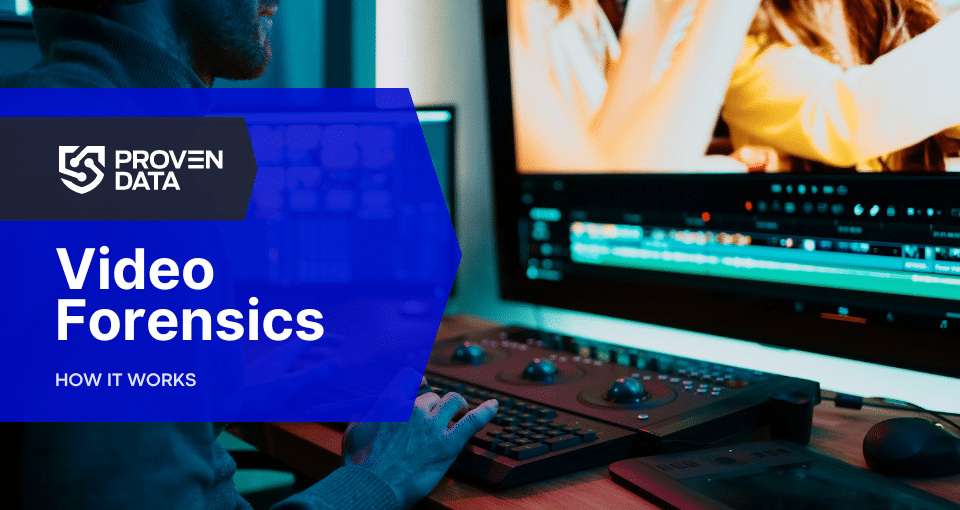Video forensics is the scientific examination and evaluation of video footage for legal purposes. This area of digital forensics has become essential for law enforcement, attorneys, and courts.
Video forensics is vital in verifying the truthfulness and accuracy of video evidence presented in court. As surveillance cameras, body cams, and smartphones capture more of our daily lives, the need for expert analysis of this footage has grown exponentially.
Whether enhancing clarity, authenticating footage, or providing expert testimony, video forensics services support the pursuit of justice through cutting-edge techniques.
When do you need video forensics services
Video forensics services are crucial in various scenarios where video evidence plays a significant role in legal proceedings or investigations.
Some examples include:
- Legal cases involving video evidence: When video footage is key evidence in a criminal or civil case, professional analysis ensures its admissibility and reliability in court.
- Insurance claims and investigations: For cases involving accidents, property damage, or other insured events captured on video, forensic analysis can provide crucial details and verify the authenticity of the footage.
- Law enforcement investigations: In criminal investigations, video evidence often needs to be enhanced, authenticated, or analyzed to identify suspects or understand the sequence of events.
- Corporate security incidents: When businesses face security breaches or internal investigations, video forensics can help uncover critical information from surveillance footage.
- Accident reconstruction: In cases of vehicle accidents or industrial incidents, video forensics can help reconstruct events and determine factors contributing to the accident.
- Verification of edited or tampered footage: If there are suspicions that video evidence has been manipulated, forensic analysis can confirm or disprove these claims.
It is not unusual for users to upload videos to AI platforms to confirm they were tampered with. However, this is not a reliable analysis. It’s important to note that only professional video forensics services are admissible in court and other legal cases. The reasons for that include:
- Specialty tools and expertise are required to analyze and enhance video evidence properly.
- Proper handling and documentation are crucial for maintaining the admissibility of evidence in court.
- Expert analysts can provide testimony to support their findings.
- DIY methods or consumer-grade software may not meet the standards required for legal proceedings.
How video forensics works
Video forensics analysis covers several steps and processes to ensure the quality and validity of the collected data. These include:
Video enhancement and clarity improvement
This process uses sophisticated software tools to improve the visual quality of video footage. For example, noise reduction algorithms remove visual artifacts and graininess, making details more visible. Sharpening techniques enhance edge definition and fine details. Video stabilization corrects for camera shake, resulting in smoother footage. Color correction and contrast adjustment can also be applied to improve overall visibility.
Geospatial and motion analysis
Analysts can extract location, distance, and speed information from video footage. They may use reference objects of known size to calculate dimensions and distances within the scene. Motion tracking algorithms can be applied to measure the speed and trajectory of moving objects or people. This analysis is helpful in accident reconstruction or crime scene analysis.
Facial recognition and object tracking
Facial recognition software can match faces in the video to known databases or compare faces across multiple videos. Object tracking involves following specific items (e.g., vehicles, weapons) as they move through the scene, even when partially obscured. This can help establish timelines and movement patterns in complex scenarios.
Video authentication and integrity assessment
Analysts examine metadata, file structures, and encoding information to detect inconsistencies and verify whether a video has been tampered with or altered. They may look for signs of splicing, frame insertion or deletion, or other manipulations. Hash values and digital signatures can establish if a file has been changed since its creation. This assessment is crucial for establishing the admissibility and reliability of video evidence in legal proceedings.
Frame-by-frame analysis
Analysts meticulously examine each individual frame of a video sequence to detect subtle changes, brief events, or details that might be missed at normal playback speed. This technique can reveal inconsistencies that indicate tampering, such as sudden changes in lighting or shadows. It is also useful for identifying the exact timing of events within the video.
Video timeline reconstruction
This involves synthesizing footage from multiple cameras or sources to create a comprehensive chronological sequence of events. Analysts synchronize timestamps, align geographical data, and combine fragmented video evidence to form a coherent narrative. This can be crucial in complex investigations involving multiple locations or extended periods.
Audio analysis
While primarily focused on video, forensic analysts also examine accompanying audio tracks. They can enhance audio quality, isolate specific sounds, and even perform voice identification. Techniques such as spectral analysis can reveal information about the recording environment or identify edited audio portions.
Camera identification
Each camera leaves unique “fingerprints” on the videos it produces based on its sensor characteristics and internal processing. Analysts can examine these patterns to identify the specific make and model of the camera used or even link footage to a particular device. This can be useful in verifying the source of video evidence or detecting when multiple cameras were used.
Deepfake detection
As AI-generated fake videos (deepfakes) become more sophisticated, video forensics experts have developed new techniques to detect them:
Facial analysis: Examining inconsistencies in facial movements, blinking patterns, and skin textures.
Audio-visual sync: Checking for misalignment between lip movements and speech.
Metadata examination: Looking for signs of manipulation in file information.
AI-based detection: Using machine learning models trained to identify AI-generated content.
In conclusion, as the prevalence of surveillance cameras and smartphones continues to rise, the demand for skilled video forensic analysts will only increase. By leveraging cutting-edge techniques, these professionals not only support the pursuit of justice but also help maintain the integrity of the legal process. Whether in criminal investigations, insurance claims, or corporate security, video forensics is a critical tool in uncovering the truth behind recorded events.







